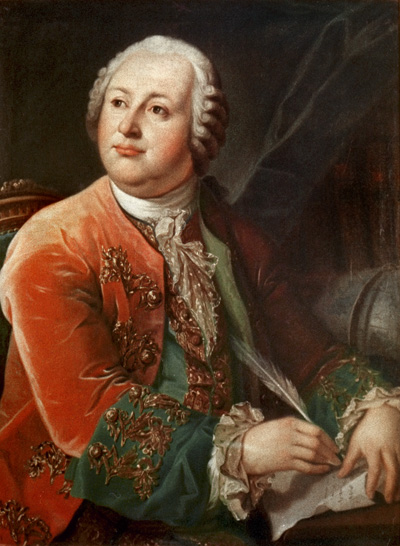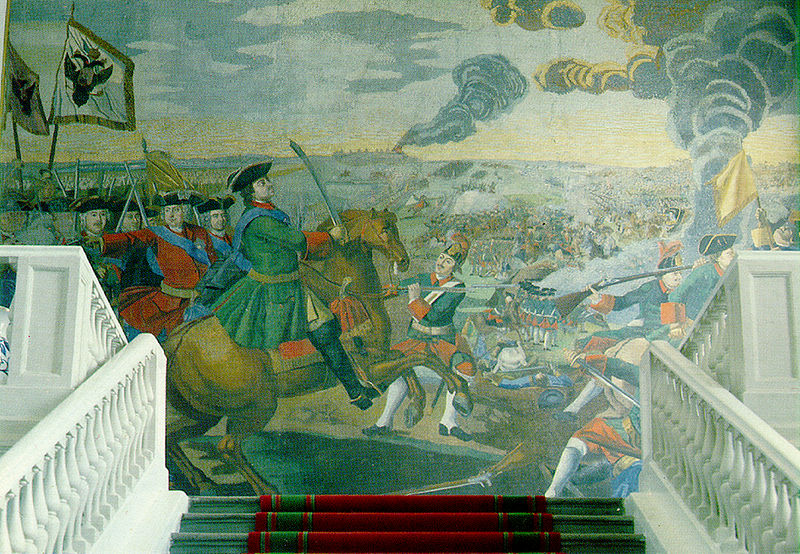<Back to Index>
- Natural Scientist Mikhail Vasilyevich Lomonosov, 1711
- Painter Eustache Le Sueur, 1617
- King of England, Scotland and Ireland Charles I, 1600
PAGE SPONSOR


Mikhail (Mikhaylo) Vasilyevich Lomonosov (Russian: Михаи́л Васи́льевич Ломоно́сов; November 19 [O.S. November 8] 1711 – April 15 [O.S. April 4] 1765) was a Russian polymath, scientist and writer, who made important contributions to literature, education, and science. Among his discoveries was the atmosphere of Venus. His spheres of science were natural science, chemistry, physics, mineralogy, history, art, philology, optical devices and others. Lomonosov was also a poet, who created the basis of the modern Russian literary language.
Lomonosov was born in the village of Denisovka (later renamed Lomonosovo in his honor) in the Arkhangelsk Governorate, on an island not far from Kholmogory, in the Far North of Russia. His
father, Vasily Dorofeyevich Lomonosov, was a prosperous peasant
fisherman turned ship owner, who amassed a small fortune transporting
goods from Arkhangelsk to Pustozyorsk, Solovki, Kola, and Lapland. Lomonosov’s mother was Vasily’s first wife, a deacon’s daughter, Elena Ivanovna Sivkova. He
remained at Denisovka until he was ten, when his father decided that he
was old enough to participate in his business ventures, and Lomonosov
began accompanying Vasily on trading missions. Learning
was young Lomonosov's passion, however, not business. The boy's thirst
for knowledge was unbounded. Lomonosov had been taught to read as a boy
by his neighbor Ivan Shubny, and he spent every spare moment with his
books. He
continued his studies with the village deacon, S.N. Sabelnikov, but for
many years the only books he had access to were religious texts. When
he was fourteen, Lomonosov was given copies of Meletius Smotrytsky's Modern Church Slavonic (a grammar book) and Leonty Magnitsky's Arthimetic. In
1724, his father married for the third and final time. Lomonosov and
his stepmother Irina had an acrimonious relationship. Unhappy at home
and intent on obtaining a higher education, which Lomonosov could not
receive in Denisovka, he was determined to leave the village. In 1730, at nineteen, Lomonosov joined a caravan traveling to Moscow. Not long after arriving, Lomonosov obtained admission into the Slavic Greek Latin Academy by falsely claiming to be a priest’s son. That initial falsehood would nearly get him expelled from the academy a few years later when discovered. Lomonosov lived on three kopecks a day, eating only black bread and kvas, but he made rapid progress scholastically. After three years in Moscow he was sent to Kiev to study for one year at the Kiev Mogila Academy. He quickly became dissatisfied with the education he was receiving
there, and returned to Moscow several months ahead of schedule,
resuming his studies there. He
completed a twelve-year study course in only five years, graduating at
the top of his class. In 1736, Lomonosov was awarded a scholarship to Saint Petersburg State University. He plunged into his studies and was rewarded with a two-year grant to study abroad at the University of Marburg, in Germany. Lomonosov
returned to Russia in 1741. A year later he was named adjutant to the
Russian Academy of Science in the physics department. In
May 1743, Lomonosov was accused, arrested, and held under house arrest
for eight months, after he supposedly insulted various people
associated with the Academy. He was released and pardoned in January
1744 after apologising to all involved. Lomonosov was made a full member of the Academy, and named professor of chemistry, in 1745. He established the Academy's first chemistry laboratory. Eager to improve Russia’s educational system, in 1755, Lomonosov joined his patron Count Ivan Shuvalov in founding the Moscow State University. In 1756, Lomonosov tried to replicate Robert Boyle's experiment of 1673. He concluded that the commonly accepted phlogiston theory was false. Anticipating the discoveries of Antoine Lavoisier,
he wrote in his diary: "Today I made an experiment in hermetic glass
vessels in order to determine whether the mass of metals increases from
the action of pure heat. The experiments – of which I append the record
in 13 pages – demonstrated that the famous Robert Boyle was deluded,
for
without access of air from outside the mass of the burnt metal remains
the same". He regarded heat as a form of motion, suggested the wave theory of light, contributed to the formulation of the kinetic theory of gases, and stated the idea of conservation of matter in
the following words: "All changes in nature are such that inasmuch is
taken from one object insomuch is added to another. So, if the amount
of matter decreases in one place, it increases elsewhere. This
universal law of nature embraces laws of motion as well, for an object
moving others by its own force in fact imparts to another object the
force it loses" (first articulated in a letter to Leonhard Euler dated
5 July 1748, rephrased and published in Lomonosov's dissertation
"Reflexion on the solidity and fluidity of bodies", 1760). In 1762, Lomonosov presented an improved design of a reflecting telescope to the Russian Academy of Sciences forum. His telescope had its primary mirror adjusted
at four degrees to telescope's axis. This made the image focus at the
side of the telescope tube. There the observer could view the image
with an eyepiece without
blocking the image. However, this invention was not published until
1827, so this type of telescopes has become associated with a similar
design by William Herschel, the Herschelian telescope. Lomonosov was the first person to record the freezing of mercury and to hypothesize the existence of an atmosphere on Venus based on his observation of the transit of Venus of 1761 in a small observatory near his house in Petersburg. Believing that nature is subject to regular and continuous evolution, he demonstrated the organic origin of soil, peat, coal, petroleum and amber. In 1745, he published a catalogue of over 3,000 minerals, and in 1760, he explained the formation of icebergs. As a geographer, Lomonosov got close to the theory of continental drift, theoretically predicted the existence of Antarctica (he argued that icebergs of the South Ocean could only be formed on a dry land covered with ice),
and invented sea tools which made writing and calculating directions
and distances easier. In 1764, he organized an expedition (led by
Admiral Vasili Chichagov) to find the Northeast Passage between the Atlantic and Pacific oceans by sailing along the northern coast of Siberia. Lomonosov was proud to restore the ancient art of mosaics. In 1754, in his letter to Leonard Euler,
he wrote that his three years of experiments on the effects of
chemistry of minerals on their colour led to him becoming very involved
into the mosaics art. In 1763, he set up a glass factory that produced the first stained glass mosaics outside of Italy.
There were forty mosaics attributed to Lomonosov, with only twenty-four
surviving to the present day. Among the best is the portrait of Peter the Great and the Battle of Poltava, measuring 4.8 x 6.4 meters. In 1755, he wrote a grammar that reformed the Russian literary language by combining Old Church Slavonic with the vernacular tongue. To further his literary theories, he wrote more than 20 solemn ceremonial odes, notably the Evening Meditation on the God's Grandeur.
He applied an idiosyncratic theory to his later poems – tender subjects
needed words containing the front vowel sounds E, I, YU, whereas things
that may cause fear (like "anger", "envy", "pain" and "sorrow") needed
words with back vowel sounds O, U, Y. That was a version of what is now
called sound symbolism. Lomonosov published a history of Russia in 1760. In addition, he unsuccessfully attempted to write an epic about Peter the Great, to be based on the Aeneid by Vergil. In 1761, he was elected a foreign member of the Royal Swedish Academy of Sciences.
In 1764, Lomonosov was appointed to the position of secretary of state.
He died one year later in Saint Petersburg. Most of his accomplishments
were unknown outside Russia until long after his death. His granddaughter Sophia Konstantinova (1769 - 1844) married Russian military hero and statesman General Nikolay Raevsky. His great-granddaughter was Princess Maria (Raevskaya) Volkonskaya, the wife of the Decembrist Prince Sergei Volkonsky. A lunar crater bears his name, as does a crater on Mars. In 1948, the underwater Lomonosov Ridge in the Arctic Ocean was named in his honor. Moscow State University was renamed ‘’M.V. Lomonosov Moscow State University’’ in his honor in 1940.
The University of Marburg was among Europe's most important universities in the mid-18th century due to the presence of the philosopher Christian Wolff, a prominent figure of the German Enlightenment.
Lomonosov became one of Wolff’s personal students while at Marburg.
Both philosophically and as a science administrator, this connection
would be the most influential of Lomonosov’s life. Lomonosov quickly mastered the German language, and in addition to philosophy, seriously studied chemistry, discovered the works of 17th century English theologian and natural philosopher, Robert Boyle, and even began writing poetry. He also developed an interest in German literature. He is said to have especially admired Günther. His Ode on the Taking of Khotin from the Turks, composed in 1739, attracted a great deal of attention in Saint Petersburg. During his residence in Germany, Lomonosov boarded with Catharina Zilch, a brewer’s widow. He fell in love with Catharina’s daughter Elisabeth Christine Zilch. They were married in June 1740. Lomonosov found it extremely difficult to maintain his growing family on the scanty and irregular allowance granted him by the Russian Academy of Science. As his circumstances became desperate, he resolved to return to Saint Petersburg.